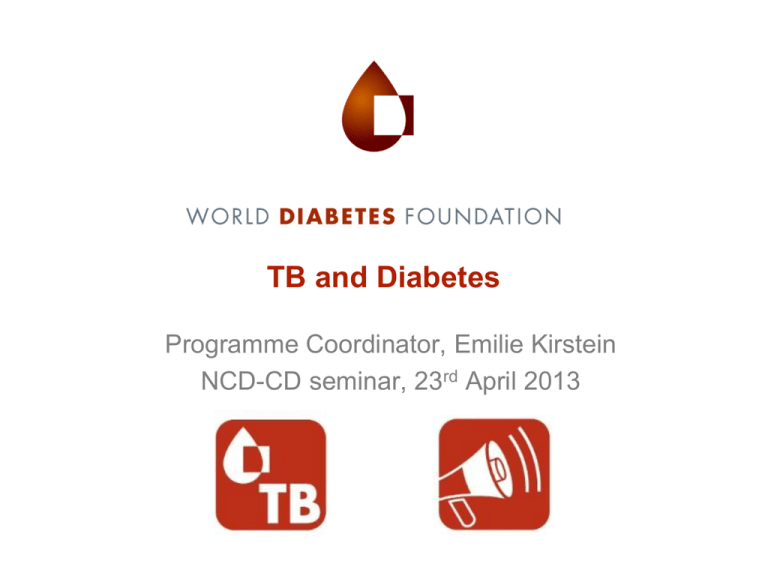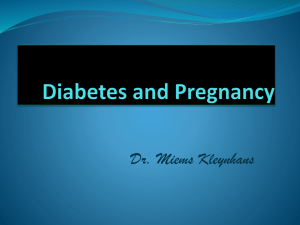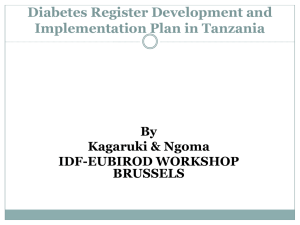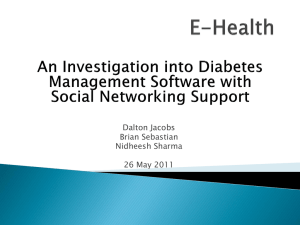Diabetes & TB - Health and Development
advertisement

TB and Diabetes Programme Coordinator, Emilie Kirstein NCD-CD seminar, 23rd April 2013 WDF was founded in 2002 • • • • • Initiated by a grant from Novo Nordisk A/S of DKK 1.1 Billion. / USD 195 mill. Registered in Denmark as an independent trust Six board members – majority external of Novo Nordisk Chairman: Professor Pierre Lefèbvre (Former President of IDF) 279 projects funded to date in 100 countries / 15 projects based on fundraising Key diabetes focus areas • • • • • • • • The diabetic foot (prevention of amputations) Eye care (detection of diabetes, prevention of blindness) Children with diabetes (prevention, education, treatment) Mothers and diabetes (nutrition, prevention, education) The Coming Generation – primary prevention TB & DM – prevention, capacity building and Care Access to diabetes care Advocacy – building a global alliance WDF Distribution of project funding Regional burden of diabetes. (Source: IDF 4th Edition) WDF distributions per region 2002-2011 Western Pacific 16% Africa 32% Africa 6% Europe and Central Asia 5% Western Pacific 31% Latin America and Caribbean 14% South East Asia 25% Middle East and North Africa 10% Europe and Central Asia 4% Global 4% Latin America and Caribbean 9% Middle East and North Africa 13% South East Asia 31% WDF distributions by focus areas 2002-2011 TB 1% Advocacy Foot 4% 8% Eye 13% Prevention 10% Gen. care 40% Mothers 7% Awareness 12% Children 5% Training of health care professionals • WDF has supported the training of 37.675 doctors • 39.709 nurses trained • 65.199 paramedics trained Clinics and access to care • More than 15.162 screening camps has been organised • To date, more than 7.5 million people have been screened for diabetes • 4.900 clinics and micro clinics has been funded by WDF • 1.3 million documented cases of people have been treated Mobile diabetes Care and Diabetic Retinopathy • Since 2005, the WDF has supported the funding of 16 mobile diabetes care vans • To date, more than 782.922 people have been screened for diabetes • More than 235.485 have been detected with diabetic retinopathy • 61.069 of these have been given sight saving laser treatment on site • Mobile vans operate in India, Kenya, Sudan and Thailand Saving feet, saving futures • WDF has trained 8.089 health care professionals in the area of diabetic foot care • These specially trained health care professionals have screened more than 370.692 patients and their feet, thus rescuing thousands from certain disability • 43 Foot Care projects supported by WDF in 26 Countries • Step by Step a very successful and often replicated model in WDF projects Gestational Diabetes Screening and Care • Screening saves two lifes • More than 77.324 women have been screened and 1.663 cases of GDM detected 2.240 Clinics strenthened with gestational diabetes services WDF support for children and youth ● 1.3 million school children in China, India, South Africa and Caribbean benefit from school based program for awareness and prevention of obesity and type 2 diabetes. ● WDF is supporting the “Changing Diabetes in Children” programme in collaboration with Novo Nordisk A/S and Roche for type 1 children ● WDF support is granted towards capacity building, funding of clinics, education & awareness material, camps for children and essential equipment DM & tuberculosis • • 2% of WDF funding for DM and TB (incl. advocacy) % of total distributions 2002-2011 DM and TB projects include the following areas: DM & TB 2% – Screening for DM – Training of HCPs – Testing of DOTS model for monitoring – Development of guidelines – Advocacy / raising awareness of links between DM & TB Other focus areas WDF distributions to focus area regional segmentation 2002-2011 Effect of DM & TB projects • • • • 9 projects focussing on improving detection and care of diabetes among TB patients in 9 countries 1,427 HCPs trained in diabetes diagnosis WDF distributions to DM & TB 2002-2011 Western Pacific 28% 10,487 TB patients screened for diabetes India: Preliminary results show crude prevalence of 25.3% in TB patients and that 16% were known to have diabetes and 9.3% were newly diagnosed. The prevalence of pre-diabetes was 24.6% among TB patients Africa 12% Global 22% South East Asia 20% Latin America and Caribbean 18% Collaborative framework for TB and DM • The WDF, which has joined forces with the World Health Organisation and the International Union Against Tuberculosis and Lung Disease, is keen to encourage “bidirectional” screening, where those diagnosed with TB would be checked for diabetes and vice versa. • In 2011, the three organisations launched a collaborative framework for care and control of tuberculosis and diabetes – a guide to detecting and managing diabetes and TB together, and further investigating the links between the two diseases. “We wanted to help build evidence of the ‘double burden’ of diabetes and TB,” Dr Kapur says. The TB / Diabetes Framework Circulated to the WHO and The Union networks, and other partners in TB control Presented in the UN Summit on NCDs • NCD Alliance September 2011 • PAHO Partners Forum 20th September 2011 17th Field testing in countries: • • • • Document available at: Sri Lanka Mexico China India etc… Presentations at the Union conference in Lille & Diabetes Congress in Dubai Research, including operational research linked to field testing http://www.who.int/tb/publications/2011/en/index.html TB and DM burdens DM Burden TB Burden • 366 million people living with DM in 2011 • 8,8 million people living with TB in 2010 • 6 million new cases each year • 9.4 million new cases each year • 4.6 million people died of DM in 2011 • 1.4 million people died of TB in 2010 Global distribution TB DM • South East Asia 20% • South East Asia 35% • Western Pacific 23% • Western Pacific 20% • Africa • Africa 5% 80% in LIC and MIC 30% 95% in LIC and MIC Diabetes and Tuberculosis - the converging pandemics Risk factors for diabetes and TB Why the link, when DM is a metabolic disorder and TB is an infectious disease? • Tobacco smoking and alcoholism may both predispose for diabetes and TB. DM patients: • Poorly controlled diabetes can lead to increased susceptibility of infection, such as TB, at a cellular and immunological levels. – DM patients have evidence of impaired cell-mediated immunity, micronutrient deficiency, pulmonary micro-angiopathy and renal insufficiency, all of which predispose to TB. TB patients • TB patients have a higher risk of developing diabetes, but it is unclear if TB can directly cause diabetes → glucose intolerance / diabetes may have been undiagnosed Public health relevance of the association How does TB affect diabetes patients? TB is associated with worsening glycaemic control in people with diabetes: - The risk is related to how the blood glucose levels varies, i.e. uncontrolled diabetes and the length of period of uncontrolled diabetes. - Higher hyperglycaemia, the higher the risk – for example T1DM patients are likely to be more underweight and typically have uncontrolled diabetes. Medications for TB may interfere with the treatment of diabetes through drug interactions. The onset of diabetes may be triggered by TB. TB infection may progress at a faster rate in people with diabetes than in those without diabetes. Public health relevance of the association How does diabetes affect TB patients? • • • • • • People with diabetes have a 2-3 times higher risk of developing TB disease compared to people without diabetes. People with TB and coexisting diabetes have 4 times higher risk of death during TB treatment and higher risk of TB relapse after treatment. People with TB and coexisting diabetes are more likely to be sputum positive and take longer to become sputum negative. Diabetes may adversely affect TB treatment outcomes by delaying the response time to treatment. The emergence of drug-resistant TB may be accelerated by diabetes. Diabetes may interfere with the activity of TB medications. The three areas of recommendations Document available at: http://www.who.int/tb/publications/2011/en/index.html Determining number of patients to be screened • • • Number of TB cases needed to be screened to find one DM case is generally low (<10), and in some settings the DM prevalance among TB patients is 40-50% (e.g. Mexico, Pacific Islands, and growing number of middle income countries). Appropriateness of TB screening in people with DM depends on local TB burden. If TB prevalence is less than 25 per 100,000 persons, at least 1000 people with DM would need to be screened to diagnose one case of TB, whereas in high TB burden countries the number needed to be screened is about 100-300. Only in high TB burden countries is it economically efficient to screen people with diabetes for TB. Screening recommendation for diabetes in TB patients • • • Screen at time of registration with random blood glucose (RBG) If RBG > 6.1 mmol/l (110mg/dl), then conduct fasting blood glucose at next visit (during initial phase of antituberculosis treatment) If fasting blood glucose > 7.0 mmol/l (126 mg/dl), then diagnosis = DM Refer to DM care if FBG > 7.0 mmol/l Screening recommendation for TB in diabetes patients Symptom based inquiry: • Is there a current cough and has the cough lasted for > 2 weeks; Is there unintentional and significant weight loss in last 4 weeks; Has there been night sweats in last 4 weeks; Has there been fever in last 4 weeks; Is there a suspicion of tuberculosis • • TB symptom screening should be done every time the patient comes to clinic If positive to any one of the 5 symptoms then this is a positive screen If symptom screen is positive, refer to TB investigations WDF distributions to DM & TB 2002-2011 (incl. advocacy) • WDF08-380 China • WDF08-385 India • WDF09-451 Malawi • WDF10-567 Nigeria • WDF10-530 Mexico and Brazil • WDF10-585 India and China • WDFI08-371 Advocacy (incl. meetings in Paris , Cancun & Kuala Lumpur and publications) • WDF12-621 Indonesia • WDF12-706 South Africa WDF distributions to DM & TB 2002-2011 Western Pacific 28% Africa 12% Global 22% South East Asia 20% Latin America and Caribbean 18% 7 7,523 6 136 30,537 1 million 2% USD 2,270.084 98% Epidemiological results from WDF projects • TB patients screened for diabetes – In India, results have shown that prevalence of diabetes among TB – – • patients ranges between 13-25%, the highest being the particularly in the South → this fits well the 3-fold risk (WDF08-385 & WDF10-585). In China results have shown that the prevalence of diabetes among TB patients has shown to be 12.4% (WDF10-585). In Nigeria results have shown that the prevalence of diabetes among TB patients has shown to be 12% (WDF10-567). Diabetes patients screened for TB: – In India, results have shown that – the incidence rate of TB among diabetes patients was almost 8 timer higher, as compared to TB cases in general population (WDF10-585). In China results have shown that the that the incidence rate of TB among diabetes patients was almost 5.5 timer higher, as compared to TB cases in general population(WDF10-585). Prevalence rates dependant on two major factors: Prevalence rate in population and the screening methodology (RBG, FBG or OGTT). Lesson learnt & challenges • Cross-referral between TB and DM care - Who is responsible? → It is unlikely that diagnosis and treatment of both conditions will be managed in the same clinic. • Screening TB patients for DM is easier than vice versa → screening DM patients for TB requires proxy questions for TB symptoms upon every visit. • • Creating linkages between care networks of TB and DM is imperative, but challenging: – TB and DM programmes have different sources of funding – Vertical programming frame of mind is still prevailing WDF funded projects are not research studies but are operational research studies which illustrate how routine screening can be done in practice. Lesson learnt & challenges, cont • • TB clinics / units are available at most PHC, secondary and tertiary care levels are more often quite well established (funding + resources + existence), which have proven easier to set up / integrate diabetes screening → HIV / TB experience. DM clinics often do not exist at PHC level and if they do, they do not always run on a weekly basis - they are often weaker as compared to TB units (limited funding and / or resources) → lack of systematic approach. Articles recommended for reading • • • • • • Ottmani SE, Murray MB, Jeon CY, Baker MA, Kapur A, Lönnroth K Harries AD. Consultation Meeting on Tuberculosis and Diabetes Mellitus: Meeting summary and recommendations. Int J Tuberc Lung Dis 2010. Harries AD, Murray MB, Jeon CY, Ottmani SE, Lönnroth, K, et al. Defining the research agenda to reduce the joint burden of disease from Diabetes mellitus and Tuberculosis. Trop Med Int Health 2010; 15: 659–663. Jeon CY, Harries AD, Baker MA, Hart JE, Kapur A, Lönnroth K, Ottmani SE, Goonesekera S, Murray M. Bi-directional screening for tuberculosis and diabetes: a systematic review. TMIH 2010. Harries AD, Lin Y, Satyanarayana S, Lönnroth K, Li L, Wilson N, et al.. The looming epidemic of diabetes-associated tuberculosis: learning lessons from HIV-associated tuberculosis. Int J Tuberc Lung Dis 2011. Dooley KE, Chaisson RE:Tuberculosis and diabetes mellitus: convergence of two epidemics. Lancet Infect Dis. 2009 Dec;9(12):737-46. In preparation: Kapur A & Harries AD. The double burden of diabetes and tuberculosis – public health implications. Thank you! www.worlddiabetesfoundation.org







